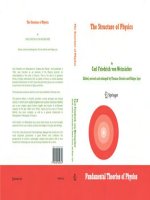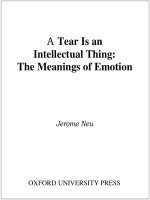- Trang chủ >>
- Khoa Học Tự Nhiên >>
- Vật lý
Denis weaire, tomaso aste the pursuit of perfect packing institute of physics pub (2000)
Bạn đang xem bản rút gọn của tài liệu. Xem và tải ngay bản đầy đủ của tài liệu tại đây (1.8 MB, 147 trang )
The Pursuit of Perfect Packing
www.pdfgrip.com
The Pursuit of Perfect Packing
Tomaso Aste
Istituto Nazionale per la Fisica della Materia, Genoa,
Italy
and
Denis Weaire
Trinity College, Dublin, Ireland
Institute of Physics Publishing
Bristol and Philadelphia
www.pdfgrip.com
c IOP Publishing Ltd 2000
All rights reserved. No part of this publication may be reproduced, stored
in a retrieval system or transmitted in any form or by any means, electronic,
mechanical, photocopying, recording or otherwise, without the prior permission
of the publisher. Multiple copying is permitted in accordance with the terms
of licences issued by the Copyright Licensing Agency under the terms of its
agreement with the Committee of Vice-Chancellors and Principals.
British Library Cataloguing-in-Publication Data
A catalogue record for this book is available from the British Library.
ISBN 0 7503 0648 3 pbk
0 7503 0647 5 hbk
Library of Congress Cataloging-in-Publication Data are available
Publisher: Nicki Dennis
Commissioning Editor: Jim Revill
Production Editor: Simon Laurenson
Production Control: Sarah Plenty
Cover Design: Victoria Le Billon
Marketing Executive: Colin Fenton
Published by Institute of Physics Publishing, wholly owned by The Institute of
Physics, London
Institute of Physics Publishing, Dirac House, Temple Back, Bristol BS1 6BE,
UK
US Office: Institute of Physics Publishing, The Public Ledger Building, Suite
1035, 150 South Independence Mall West, Philadelphia, PA 19106, USA
Typeset in TEX using the IOP Bookmaker Macros
Printed in the UK by J W Arrowsmith Ltd, Bristol
www.pdfgrip.com
Dedicated by TA to Nicoletta
www.pdfgrip.com
www.pdfgrip.com
Contents
Preface
xi
1 How many sweets in the jar?
1
2 Loose change and tight packing
2.1 A handful of coins
2.2 When equal shares are best
2.3 Regular and semi-regular packings
2.4 Disordered, quasi-ordered and fractal packings
2.5 The Voronoă construction
5
5
6
11
13
16
3 Hard problems with hard spheres
3.1 The greengrocers dilemma
3.2 Balls in bags
3.3 A new way of looking
3.4 How many balls in the bag?
3.5 Osborne Reynolds: a footprint on the sand
3.6 Ordered loose packings
3.7 Ordered close packing
3.8 The Kepler Conjecture
3.9 Marvellous clarity: the life of Kepler
3.10 Progress by leaps and bounds?
20
20
20
22
24
24
27
27
29
32
34
4 Proof positive?
4.1 News from the Western Front
4.2 The programme of Thomas Hales
4.3 At last?
4.4 Who cares?
4.5 The problem of proof
4.6 The power of thought
35
35
37
39
42
43
44
www.pdfgrip.com
viii
Contents
5 Peas and pips
5.1 Vegetable staticks
5.2 Stephen Hales
5.3 Pomegranate pips
5.4 The improbable seed
5.5 Biological cells, lead shot and soap bubbles
45
45
47
48
48
50
6 Enthusiastic admiration: the honeycomb
6.1 The honeycomb problem
6.2 What the bees do not know
54
54
56
7 Toils and troubles with bubbles
7.1 Playing with bubbles
7.2 A blind man in the kingdom of the sighted
7.3 Proving Plateau
7.4 Foam and ether
7.5 The Kelvin cell
7.6 The twinkling of an eye
7.7 Simulated soap
7.8 A discovery in Dublin
59
59
60
63
65
68
70
71
72
8 The architecture of the world of atoms
8.1 Molecular tactics
8.2 Atoms and molecules: begging the question
8.3 Atoms as points
8.4 Playing hardball
8.5 Modern crystallography
8.6 Crystalline packings
8.7 Tetrahedral packing
8.8 Quasicrystals
8.9 Amorphous solids
8.10 Crystal nonsense
75
75
77
78
80
82
83
85
87
89
90
9 Apollonius and concrete
9.1 Mixing concrete
9.2 Apollonian packing
9.3 Packing fraction and fractal dimension
9.4 Packing fraction in granular aggregate
91
91
93
94
95
10 The Giant’s Causeway
10.1 Worth seeing?
10.2 Idealization oversteps again
10.3 The first official report
10.4 Mallett’s model
10.5 A modern view
10.6 Lost city?
97
97
98
99
101
102
102
www.pdfgrip.com
Contents
ix
11 Soccer balls, golf balls and buckyballs
11.1 Soccer balls
11.2 Golf balls
11.3 Buckyballs
11.4 Buckminster Fuller
11.5 The Thomson problem
11.6 The Tammes problem
11.7 Helical packings
103
103
103
105
107
107
108
110
12 Packings and kisses in high dimensions
12.1 Packing in many dimensions
12.2 A kissing competition
12.3 More kisses
113
113
116
117
13 Odds and ends
13.1 Parking cars
13.2 Stuffing sausages
13.3 Filling boxes
13.4 Goldberg variations
13.5 Packing pentagons
13.6 Dodecahedral packing and curved spaces
13.7 The Malfatti problem
13.8 Microspheres and opals
13.9 Order from shaking
13.10 Segregation
13.11 Turning down the heat: simulated annealing
119
119
120
121
122
123
124
125
126
127
129
130
14 Conclusion
133
Index
134
www.pdfgrip.com
www.pdfgrip.com
Preface
There are many things which might be packed into a book about packing. Our
choice has been eclectic. Around the mathematical core of the subject we have
gathered examples from far and wide.
It was difficult to decide how to handle references. This is not intended as
a heavyweight monograph or an all-inclusive handbook, but the reader may well
wish to check or pursue particular topics. We have tried to give a broad range
of general references to authoritative books and review articles. In addition we
have identified the original source of many of the key results which are discussed,
together with enough clues in the text to enable other points to be followed up,
for example with a biographical dictionary.
Thanks are due to many colleagues who have helped us, including Nicolas
Rivier (a constant source of stimulation and esoteric knowledge), Stefan Hutzler
and Robert Phelan. Rob Kusner and Jăorg Wills made several suggestions for the
text, which we have adopted.
Denis Weaire benefited from the research support of Enterprise Ireland and
Shell during the period in which this was written, and Tomaso Aste was a Marie
Curie Research Fellow of the EU during part of it.
Tomaso Aste
Denis Weaire
December 1999
xi
www.pdfgrip.com
Chapter 1
How many sweets in the jar?
The half-empty suitcase or refrigerator is a rare phenomenon. We seem to spend
much of our lives squeezing things into tight spaces, and scratching our heads
when we fail. The poet might have said: packing and stacking we lay waste our
days.
To the designer of circuit boards or software the challenge carries a stimulating commercial reward: savings can be made by packing things well. How can
we best go about it, and how do we know when the optimal solution has been
found?
This has long been a teasing problem for the mathematical fraternity, one in
which their delicate webs of formal argument somehow fail to capture much certain knowledge. Their frustration is not shared by the computer scientist, whose
more rough-and-ready tactics have found many practical results.
Physicists also take an interest, being concerned with how things fit together
in nature. And many biologists have not been able to resist the temptation to
look for a geometrical story to account for the complexities of life itself. So our
account of packing problems will range from atoms to honeycombs in search of
inspiration and applications.
Unless engaged in smuggling, we are likely to pack our suitcase with miscellaneous items of varying shape and size. This compounds the problem of how
to arrange them. The mathematician would prefer to consider identical objects,
and an infinite suitcase. How then can oranges be packed most tightly, if we do
not have to worry about the container? This is a celebrated question, associated
with the name of one of the greatest figures in the history of science, Johannes
Kepler, and highlighted by David Hilbert at the start of the 20th century.
1
www.pdfgrip.com
2
How many sweets in the jar?
Figure 1.1. Stacking casks of Guinness.
Hilbert’s 18th problem
In 1900, David Hilbert presented to the International Mathematical
Congress in Paris a list of 23 problems which he hoped would guide mathematical research in the 20th century. The 18th problem was concerned
with sphere packing and space-filling polyhedra.
I point out the following question (. . . ) important to number
theory and perhaps sometimes useful to physics and chemistry:
How one can arrange most densely in space an infinite number
of equal solids of given form, e.g. spheres with given radii or
regular tetrahedra with given edges (or in prescribed positions),
that is, how can one so fit them together that the ratio of the
filled to the unfilled space may be as great as possible?
www.pdfgrip.com
How many sweets in the jar?
3
Figure 1.2. Soap bubbles.
Figure 1.3. Packing on a grand scale: Wright T 1750 The Cosmos.
More subtle goals than that of maximum density may be invoked. When
bubbles are packed tightly to form a foam, as in a glass of beer, they can adjust
their shapes and they do so to minimize their surface area. So in this case, the
total volume is fixed and it is the total area of the interfaces between the bubbles
that is minimized.
The history of ideas about packing is peopled by many eminent and colourful
characters. An English reverend gentlemen is remembered for his experiments in
squashing peas together in the pursuit of geometrical insights. A blind Belgian
scientist performed by proxy the experiments that laid the ground rules for serious
play with bubbles. An Irishman of unrivalled reputation for dalliance (at least
www.pdfgrip.com
4
How many sweets in the jar?
among crystallographers) gave us the rules for the random packing of balls. A
Scotsman who was the grand old man of Victorian science was briefly obsessed
with the parsimonious partitioning of space.
All of them shared the curiosity of the child at the church bazaar: how many
sweets are there in the jar?
www.pdfgrip.com
Chapter 2
Loose change and tight
packing
2.1 A handful of coins
An ample handful of loose change, spread out on a table, will help us understand
some of the principles of packing. This will serve to introduce some of the basic
notations of the subject, before we tackle the complexity of three dimensions and
the obscurities of higher dimensions.
Let us discard the odd-shaped coins which are becoming fashionable; we
want hard circular discs. Coins come in various sizes, so let us further simplify
the problem by selecting a set of equal size. About ten will do. The question is:
how could a large number of these coins be arranged most tightly?
If we do it in three-dimensional space, then obviously the well known bankroll is best for any number of coins. But here we restrict ourselves to twodimensional packing on the flat surface of the table.
Three coins fit neatly together in a triangle, as in figure 2.1. There is no
difficulty in continuing this strategy, with each coin eventually contacting six
neighbours. A pleasant pattern soon emerges: the triangular close packing in
two dimensions.
The fraction of table covered by coins is called the packing fraction, which
is
Area covered
ễ
(2.1)
ẳ ẳ
Total area
ẵắ
This must surely be the largest possible value. But can we prove it? That is
often where the trouble starts, but not in this case. A proof can be constructed as
follows.
5
www.pdfgrip.com
6
Loose change and tight packing
(a)
(b)
(c)
Figure 2.1. Three equal discs fit tightly in an equilateral triangle (a). This configuration
can be extended to generate the triangular close packing (b). This is the densest possible
¼ ¼
. The regular pattern
arrangement of equal discs, having packing fraction
drawn by joining the centres of touching discs is the triangular lattice (c).
2.2 When equal shares are best
There is a general principle which helps with many packing problems: it says
that, under certain circumstances, equal shares are best. (We shall resist any
www.pdfgrip.com
When equal shares are best
7
Figure 2.2. What is the best price for two fields, of a total area of 40 hectares?
temptation to draw moral lessons for politicians at this point.) A parable will
serve to illustrate this principle in action.
A farmer, attracted by certain European subsidies, seeks to purchase two
fields with a total area of 40 hectares. The prices for fields depend on the field
size as shown in the diagram of figure 2.2. What is he to do?
Playing with the different possibilities quickly convinces him that he should
buy two fields of 20 hectares each. The combination of ten and 30 hectares is
more expensive; its price is twice that indicated by the open circle on the diagram,
which lies above the price of a 20 hectare field.
What property of the price structure forces him to choose equal-sized fields?
It is the upward curvature of figure 2.2, which we may call convexity.
Packing a single disc
A packing problem may be posed for a single disc of radius Ê by requiring it to
fit into a polygonal boundary—a sheep-pen—which is as small as possible. The
sheep-pen has Ò sides: what shape should it be?
The answer is: a regular polygon (that is, totally symmetric with equal edges
and equal angles between edges).
To demonstrate this we note that the area of a polygon can be divided into
sectors, as shown in figure 2.3(a). Each sector corresponds to an angle and
the angles must add up to ¾ . We need to share this total among Ò angles. But
the area of each sector must be greater or equal than that shown in figure 2.3(b)
(isosceles triangle) and this is a convex function of .
www.pdfgrip.com
8
Loose change and tight packing
Figure 2.3. (a) A polygon with a disc inside can be divided into triangular sectors with
angles . (b) The isosceles triangle that touches the disc is the sector that minimizes the
area for a given . The area of such a sector is a convex function of , therefore a division
in equal sectors is best.
So equal angles are best, and the strategy of equal shares results in Ò such
isosceles triangles.
Packing many discs
We are ready to complete the proof of the disc-packing problem in two dimensions: what is the most dense arrangement of equal discs, infinite in number? The
answer will be the triangular close packing of figure 2.1.
In his book, which covers many such problems 1, Fejes T´oth attributes the
½
Fejes T´oth L 1953 Lagerungen in der Ebene auf der Kugel und im Raum (Die Grundlehren der
Math. Wiss. 65) (Berlin: Springer).
www.pdfgrip.com
When equal shares are best
9
Figure 2.4. A Voronoă partition around the centres of a disordered assembly of discs.
first proof of this result to the Scandinavian mathematician Thue, who in 1892
discussed the problem at the Scandinavian National Science Congress and in 1910
published a longer proof. C A Rogers expresses some objections to these proofs:
‘it is no easy task to establish certain compactness results which he takes for
granted’2.
What we present here is based on one of the proofs given by Fejes T´oth.
First, we assign to each disc in any given packing its own territory, a polygonal shape which surrounds it (as in figure 2.4). This is done by drawing a line bisecting the one which joins the centres of neighbouring discs. This is the Vorono ă
construction, to which we will return several times in this book.
We can assume that all these boundaries meet at a triple junction. (If not, just
introduce an extra boundary of zero length to make it so.) For an infinite number
of circles in the whole plane, a theorem of Euler 3 states that for such a Voronoă
pattern the average number of sides of the polygons is exactly six 4
Ò
(2.2)
The triangular pattern has Ò
for all the polygons: they are regular hexagons.
If we introduce some polygons with more sides than six, they must be compensated by others with less. Now we can use the result of the last section. The area
of the Ò-sided polygons cannot be less than that of the regular polygon which
touches the disc. This is a convex function of Ò (figure 2.5), so that once again we
can use the principle of ‘equal shares’, this time of polygon sides. The total area
for all polygons.
cannot be less than what we can obtain with Ị
¾
Rogers C A 1964 Packing and Covering (Cambridge: Cambridge University Press).
See Smith C S 1981 A Search for Structure (Cambridge, MA: MIT Press) p 5.
There are certain kinds of tilings where this equation does not hold. See Grăunbaum B and Rollet G C
1986 Tilings and Patterns (New York: Freeman).
¿
www.pdfgrip.com
10
Loose change and tight packing
Figure 2.5. The area of regular polygons with a circle inscribed is a convex function of the
number of sides of the polygons (Ò).
Here we have a pattern which, were we not to construct it in the imagination,
presents itself to us in daily life, in the packing and stacking of drinking straws
and other cylindrical objects, or the layout of eggs in a carton. It would even form
spontaneously, at least locally, if we shuffled our coins together for long enough.
There is a research group in Northern France which does just this sort of
experiment, using a gigantic air table. This is a surface with small holes through
which air is pumped, so that flat objects can glide upon it without friction.
Later we will encounter other problems which look very similar to this one,
but few of them submit to such a straightforward argument. Indeed a false sense
of security may be induced by this example. It turns out that almost any variation
of the problem renders it more mysterious.
So what is so special about the packing of these discs? It is the convenient
fact that there is a best local packing which can be extended without variation to
the whole structure. If we restore our handful of mixed change, or try to stack
www.pdfgrip.com
Regular and semi-regular packings
11
Figure 2.6. The giant air table machine (4.5 m high) constructed, in Rennes by D Bideau
and others, in order to investigate two-dimensional packings. The two men in the photograph are the builders of the system.
oranges in three dimensions instead, no such elementary argument will work.
The problem becomes one of a global optimization, which cannot always be
achieved by local optimization. It takes its place alongside many others which
practical people have to face. Under specified conditions how do we maximize
some global quantity? Given life and liberty how do we best pursue happiness,
allowing for the limitations of human nature and the competing demands of individuals?
As every democrat knows, global optimization is a matter of difficult compromise. Perfection is rarely achieved, and how do you know when you have
it?
2.3 Regular and semi-regular packings
In the previous section we learned that dividing space into equal, regular shapes
is often the most convenient strategy. In the densest packing of equal discs, each
disc is in contact with six others. Upon joining the centre of each disc with the
centres of the ones in contact with it, there emerges a tessellation (or tiling) of
www.pdfgrip.com
12
Loose change and tight packing
Figure 2.7. Spontaneous clustering into the triangular lattice for bearings on a plane shaken
vertically from high (top) to low accelerations (bottom). Single images (right column) and
second averaged images (left column). (Courtesy of J S Olafsen and J S Urbach.)
the plane made with equal, regular triangular tiles. This tessellation has three
properties:
(1) all the vertices are identical, that is, lines come together in the same way at
each of them;
(2) all tiles are regular (that is, completely symmetrical) polygons;
(3) all polygons are identical.
This is called a regular tessellation. How many tessellations with such regularity
exist? The answer is three: they correspond to the triangular, square and hexagonal cases, which are shown in figure 2.9. In these three packings the discs are
locally disposed in highly symmetrical arrangements and the whole packing can
be generated by translating on the plane a unique local configuration, as in the
simplest kinds of wallpaper.
www.pdfgrip.com
Disordered, quasi-ordered and fractal packings
(a)
13
(b)
Figure 2.8. Ordered and disordered tessellations, from the pavements of Lisbon.
By relaxing the third condition, and allowing more than one type of regular
polygon as tiles, eight other packings can be constructed. These tessellations are
named semi-regular or Archimedean by analogy with the names used for finite
polyhedra in three dimensions. Figure 2.10 shows these eight semi-regular packings and their packing fractions. Note that the lowest packing fraction among
these cases ( ẳ ẵ) is attained by the structure made with triangular and dodecagonal tiles. This brings us back to the equal shares principle, used this time
in the opposite way: very different shares give bad packing fractions.
In these semi-regular packings the whole structure can again be generated by
translating a unique local configuration (indicated by lines in figure 2.10). Such
structures are called lattices or crystalline structures. In metals, in quartz, in
diamond, and in many other solids, atoms are disposed regularly in space as in
the two-dimensional arrangements of discs previously discussed. These solids
are named crystals.
But nature is rich and diversified, and other types of packings different from
the simple crystalline ones are also found.
2.4 Disordered, quasi-ordered and fractal packings
We know that when equal coins are placed tightly on the table, an ordered, regular
configuration emerges: the triangular lattice. What happens if coins of different
sizes are used instead? Let us try to construct this packing: start with equal coins
packed regularly in the tightest way, then insert a coin of a different size. If the
coin is much smaller than the others (relative diameter less than 15% 5 ), it can be
inserted in one of the holes of the regular packing without modifying the whole
structure. In the technical jargon of the subject, this is sometimes called a ‘rattler’,
Ô
Inside the hole between three coins of diameter , packed in the tightest way, a fourth coin of
diameter equal or smaller than ẳ ắ ẵà
ẳ ẵ
à can be inserted.
www.pdfgrip.com
Loose change and tight packing
14
Figure 2.9. Regular packings of equal discs. Here the patterns formed by joining the
centres of the circles mutually in contact have identical vertices and regular, identical
polygons as tiles. These are triangles (a), squares (b) and hexagons (c). The packing
fractions are respectively
ẵắ ẳ ẳ
(a),
ẳ
(b) and
ắ ẳ ẳ
(c).
ễ
ễ
since it is free to rattle around the space available.
On the other hand, if the inserted coin is very large it requires the removal of
the original coins to accommodate it and, in the tight packing around this inter-
www.pdfgrip.com









